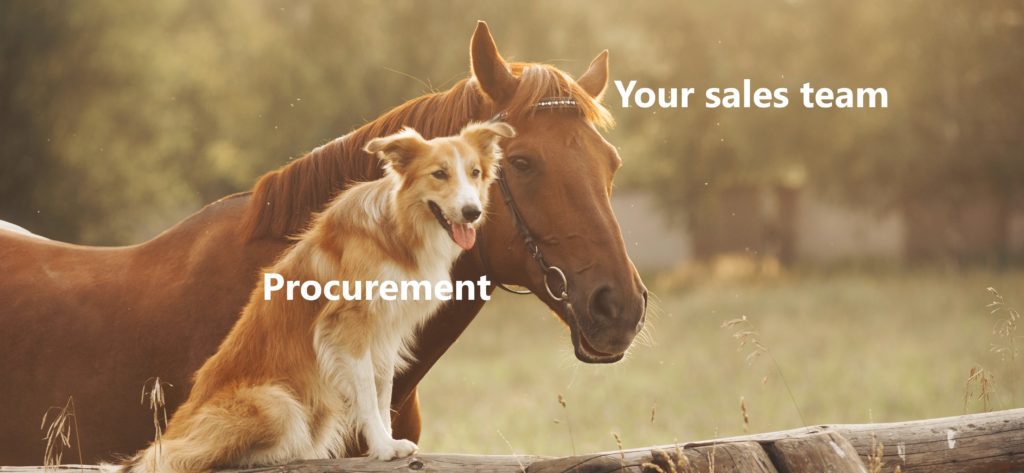Reframing Procurement: Hurdles to be Leapt or Allies to be Won?

By Tom Swanson, Engagement Manager at Heinz Marketing
“We need more enterprise clients!” is a familiar call for B2B marketers.
Obviously you want the biggest, most recognizable logos on your website as users of your genius product.
It just makes sense.
There are plenty of posts about how to generate that demand, but today I want to talk about what many revenue teams view as a major hurdle to landing enterprise deals: procurement.
The Problem with Procurement
Imagine this: you have an enterprise customer on the hook and ready to buy. Everything is going well until your contact goes dark and the deal languishes in the late stages of your pipeline. To understand why, you have a call, and they state that procurement determined your company does not meet the compliance standards needed to be an approved vendor. You go back and forth for weeks until the deal goes cold, motivation is lost, and eventually the deal dies.
Ok, some hyperbole here, but this does happen.
Procurement, also known as: vendor management, supplier management, or even sometimes supply-chain management,
are the folks who need to ensure that all the i’s are dotted and t’s are crossed.They compile all the legal, contractual, regulatory, strategic, and bureaucratic controls that need to exist to keep a company safe.
We often look at procurement as hurdles to be overcome.
They have the power to say no, and they often do.
Whether it is a contract issue, something to do with the terms, an insurmountable security challenge, compliance issues, or whatever else, they can tank a deal that is well into the late stages of your cycle.
And that is the place it hurts the most.
Bureaucracy vs. Scale
A topic I like to delight my friends with at the dinner table is the constant, unending balance of bureaucracy and scale.
The two need to move in lock-step, as one without the other can destroy an organization, be it a company, a friend group, or even a society.
The logic goes like this: organizations naturally want to scale, however as they do, they open themselves to new risks.
These are most often external risks like increased regulatory oversight and predatory actors (read: cyber attacks and legal threats), but there are internal ones too like greater HR requirements and increasingly siloed teams.
Enter the noble bureaucracy.
The role of the bureaucrat is often misunderstood, but it is most simply put this way:
Bureaucracy exists as a balance to protect an organization from the dangers of scale.
Cyber-security slows down scale to ensure that data is protected.
Legal slows down scale to ensure that the company is safe from lawsuits.
HR exists to ensure the company has the people and conditions needed to flourish.
Procurement exists to protect the company from the liability of reckless supply-chain and/or vendor scale.
These are crucial roles, but if they overstep, a company becomes slow and non-competitive. Innovation dries up, and effecting any change feels impossible.
Thus it is a balance, and an unending one at that.
The greater the scale, the more bureaucracy is needed to keep it from coming crashing down.
The business world is a dangerous place.
Reframing Bureaucracy
As business people we have a tendency to look favorably upon scale and negatively upon bureaucracy, but that needs to be reframed. The perspective shift is crucial to understanding procurement, and if done effectively, can even make valuable allies.
Procurement is doing a massively important job. If they lapse in their work, the consequences can be highly destructive, and rebuilding is very costly.
This is not even to mention the potential reputational harm such a failure can cause.
We already look to make our champion’s lives easier, we must also seek to make procurements lives easier.
Having such an important ally on your side has many benefits (provided you have met their requirements).
Here are a few examples:
Better late-stage progression rates
As referenced before, nobody likes it when a deal falls through in the 11th hour, especially the customer. If you fail here, there is something wrong in your process.
Would you have lost that deal if marketing had created materials to ease the troubled minds of our risk-averse friends? Or if sales had fully understood the needs of procurement prior to sending a proposal? Perhaps not!
Faster cycle times
Procurement can take ages.
Sometimes the stage that engages most with procurement can take as long as all the other stages combined.
If marketing is aware of how procurement works at your target accounts, you can ensure that their rules are followed at the start and move smoothly and quickly through the process.
Easier expansion deals
The vaunted land & expand is the holy grail of deals. Having a good relationship with procurement means it is easier to make these deals happen, and harder for competition to enter. If you can breeze through procurement, you have a decided competitive advantage over other newcomers. Your seat at the table is much harder to steal when procurement loves you.
Friends in high places are great. Friends in bureaucratic places are essential.
Going Forward …
Ready to embrace the bureaucracy and start enabling procurement rather than groaning when they get involved?
Here are some tips:
Know the regulatory environment
Compliance with regulations is a key component of procurement’s job.
These take two forms: first is external regulators like governments, and the other is internal regulators like HR.
You have probably heard of GDPR. Well being compliant with GDPR is crucial for companies that market and sell in Europe.
If your potential customers are concerned about this while considering your B2B SaaS product, then you need to make sure your marketing materials assuage this concern before it comes up and slows your deals.
Other regulations hit HR, legal, and especially cyber-security. Know what these are, and ensure that the enablement materials you provide your sales people can answer any questions completely.
As you pursue enterprise customers, you will also want to consider their unique internal bureaucracy. This is more situational, but is important to moving enterprise deals forward. Ask early and often.
Understand the risks and liabilities that come with your product
Empathy is the name of the game here. However, I am not writing about knowing how procurement feels, but rather what they will question. They are thinking about the risks of bringing on a new vendor.
If you are offering a new way to reach their customers, what potential risks exist that might raise red flags for procurement?
A great way to figure these out is to frequently audit sales calls where procurement is involved.
If those communications are happening on email, then talk to your sales team about the types of questions they are getting from procurement. This crucial step can help you design better enablement materials that will accelerate deals.
Talk to your customers about their procurement process, and if you can, talk directly to their procurement teams
I am a huge fan of actually talking to customers, and that is no different here. It is crucial to hear their perspectives about how they heard about you, why they decided to buy, and what their experience has been.
Additionally, if you can talk to their procurement teams, you can understand what they need to pass deals through. Per the above benefit of better land/expand potential, talking to procurement can also strengthen your relationship with key players on the buying committee for expansion deals.
Finally, if your customers tend to fall into similar buckets, this can help you get in the door with new customers by being an easier deal to pass through procurement since you have the insight into what they care about.
Produce documentation and educate your revenue teams
Finally, once you have gathered the above information, you need to operationalize it.
Produce the documentation that covers the concerns, makes them clear to sales folks, and enables them to pre-emptively deal with procurement concerns.
When you can move faster through procurement than the competition, you will win more often.
Conclusion
Procurement teams are not hurdles to be leapt, they are allies to be won.
As revenue professionals, we need to do away with the blanket-negative view of bureaucracy and see it for what it is: a crucial balance point to the risk of grand scaling.
Embrace the bureaucracy, love the bureaucrat, and win more.
As always, if you have any questions, feel free to email me: tom@heinzmarketing.com









